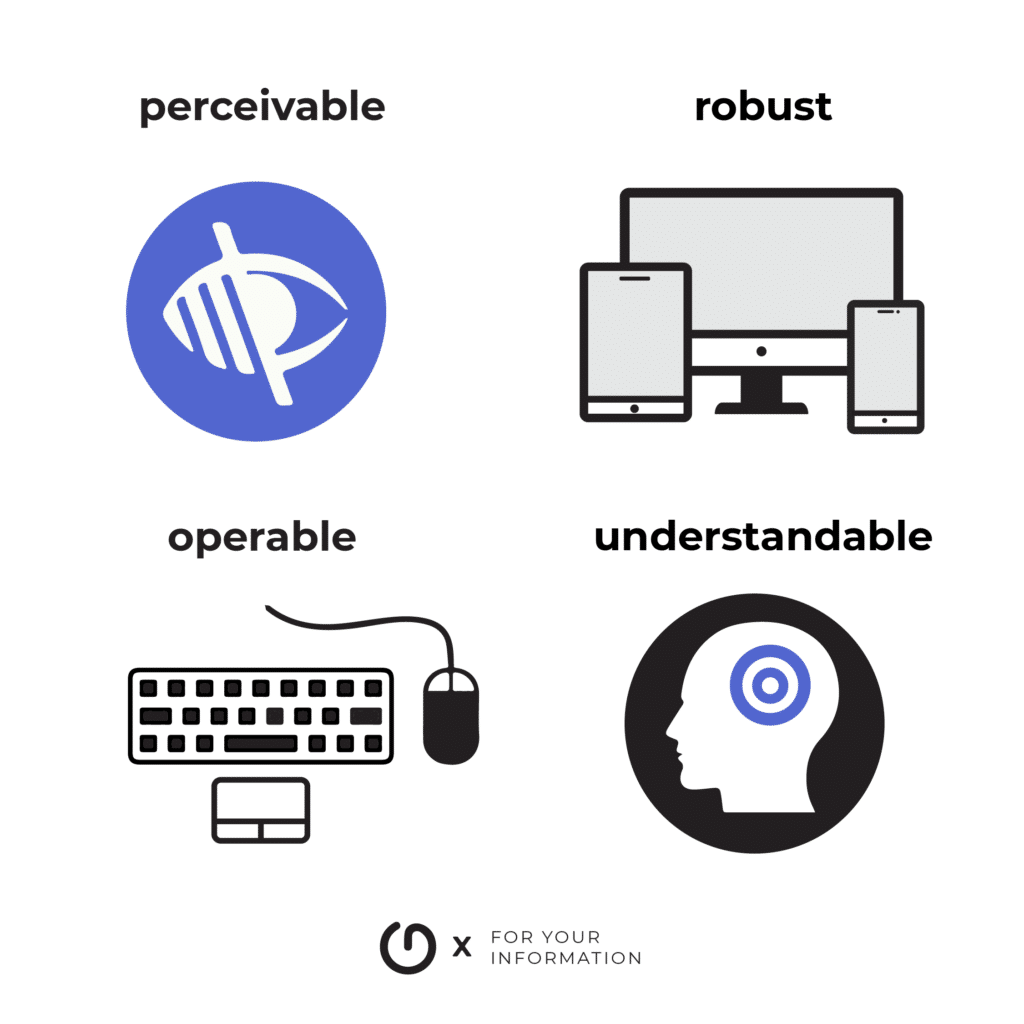The industry standard for assessing if a web page is accessible is using the Web Content Accessibility Guidelines (WCAG). These guidelines provide 4 top-level principles for determining the accessibility of a web page.

These 4 Principles are:
-
Perceivable
-
Operable
-
Understandable
-
Robust
These 4 principles are the top-level groupings used to make the 13 guidelines presented in the WCAG documentation. Here we will focus on the 4 principles and what questions need to be asked to determine the accessibility of a web page.
Perceivable
The meaning behind this can be a little confusing from a web perspective until you look up the definition of what it means for something to be perceivable: to become aware or conscious of (something); come to realize or understand.
A good example of this is using alternative text for images. If you have a banner that has text on it and there are no text alternatives for people who are using a screen-reader your content is not perceivable to those users. This means your site is not accessible. Another example of this is time-based media. If a video does not have text alternatives for people who are hearing impaired, the information in the video is not perceivable to all users.
When evaluating perceiveability, ask yourself: Is your content adaptable and distinguishable for many users?
Operable
To meet this criterion your site and any functionality must work as expected. Does your menu work properly? Not just for people with a mouse but for people who are using only a keyboard or a screen reader. Does a user have enough time to complete a task that is time-based? A user fills out a form but the page times out and refuses to submit the data. Are animations able to be turned off? If a user is trying to read a banner carousel but the carousel changes to the next slide before the user is done reading and the user is unable to stop the slider.
Website owners want their sites to be flashy and cool, but many times flashy and slick features can pose an accessibility roadblock to users. This does not mean sites shouldn’t use animations and the latest web technologies, but it means that you should take operability into consideration and make the features operable to all users.
It’s important to note that many of these features can not be automatically tested for by another computer or automated process. It is often best to have a human actually test the site and to use their best judgment on how something should function.
Understandable
Is the website content understandable? Features on the website need to function or operate in the expected manner for end-users. This applies to forms functioning in a predictable manner with keyboard focusable fields and labels as well as the reading level of text being used. All content needs to be accessible to the audience the site is targeting. Furthermore, if the text on a webpage is littered with spelling and grammatical errors that content will not be understood by users (this is especially true if the site is not in their native language or if the user has any cognitive difficulties).
In short, if a site has errors, whether that is functional or copy-based, it can block a user from understanding the information being presented.
Robust
“Content must be robust enough that it can be interpreted by a wide variety of user agents, including assistive technologies.” – WCAG
Users of a site are not just humans, but other systems that need to interpret the content. This could be a screen reader understanding where a paragraph starts and ends or a search engine collecting relevant data to present to users. If the content on a website is not marked up correctly, meaning using the correct HTML tags, the content will be more difficult or even impossible to properly parse. Imagine a webpage full of paragraphs but those paragraphs are in one HTML paragraph tag. A screen reader wouldn’t know where to place stops between those paragraphs.
Are user interface components marked up correctly? If a form does not have proper labels and field types it will be more difficult for users and other computer systems to parse. This is obviously important for the web developer developing the web page, but also for individuals putting content on web pages. Many times this is someone who has no web development experience and merely wants to display some content on the web. It’s important for everyone involved in adding content to understand what it means to make sure their content is robust and accessible.
Summary
Understanding these 4 principles is just the beginning of the full testing criteria that the WCAG outlines, but it’s an important starting point for anyone who wishes to make their content accessible. The WCAG has 14 guidelines which then has 61 testable criteria each placed into 3 conformance levels (A, AA, AAA). The sheer number of criteria aside, the most important takeaway is that many of these issues can not be automatically tested for by a computer or automated process. It’s often ideal to have a human actually test the site and make their best judgment on how something should function.
Automated processes can bring issues to light but only a human can determine the best solution for other humans, especially on the topic of accessibility. Finally, remember that this is not a one-time job. These principles must be thought about throughout the life of a website as content is added and removed.
